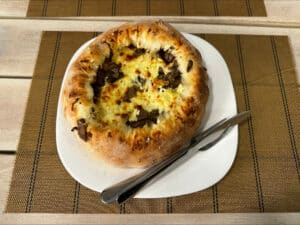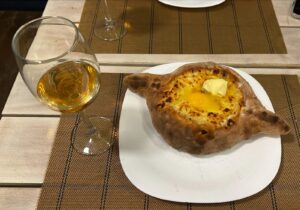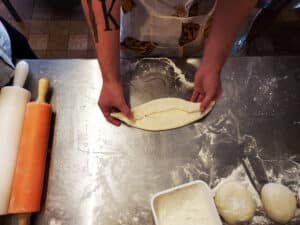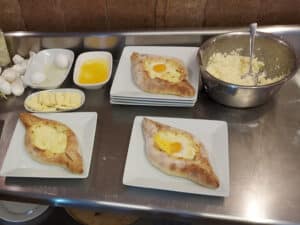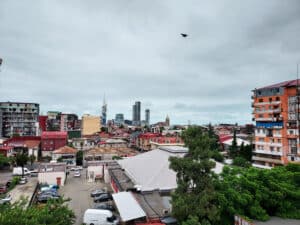Khachapuri (Хачапури) is one of the most beloved of the Georgian foods adopted into the Russian tradition. That is a major achievement, as Georgian cuisine is itself one of the most beloved of all those among the former Soviet peoples. It is enjoyed in Russia, throughout the former Soviet space, and around the world. The dish itself is simple, hearty, can travel well in some forms, and is mouthwateringly delicious. So, what is it? Cheesy bread!
How It Got Its Name
(Почему носит такое название?)
By Jordan Bryant
The name “khachapuri” comes from the Georgian names for curd cheese (хачо) and bread (пури). One note that we should probably make here is that Georgian does not use the Cyrillic alphabet officially. So, we are providing the words here in Cyrillic for the benefit of students of Russian. However, “khachapuri” written in Georgia’s own unique alphabet would actually look like this: ხაჭაპური.
There are many different regional variations of khachapuri, and each is generally named for the region and/or people who are best known for making it. The most common types of khachapuri available in Russia are: “хачапури по-имеретински” (Imeretian khachapuri); “хачапури по-аджарски” (Adjarian khachapuri); “хачапури по-мегрельски” (Mingrelian katchapori) and “хачапури по-армянски” (Armenian khachapuri).

Imeretian khachapuri is named for the Kingdom of Imeriti, one of several great kingdoms that once made up Georgia’s shifting medieval political landscape. This version presupposes a circular dough stuffed with cheese, oil and/or butter and pan-fried.
Mingrelian katchapori is named for Megrelia, along Georgia’s Black Sea coast. They put cheese inside and on top of what otherwise looks much like Imeretian khachapuri.
Adjarian khachapuri is named for Adjara, an autonomous republic in Georgia. Its dough is folded into a boat shape with the cheese inside exposed. It is oven-baked and, as it comes out, a raw egg is dropped into the center of the cheese with a pat of butter. The heat from the cheese cooks the egg to a sunny-side-up consistency.
Armenian khachapuri is the variety most often found in Russian kiosks. This type is most associated with the Armenians, an ethnic group completely separate from the Georgians who have their own country and history. Their version of this dish has the cheese wrapped inside a puff pastry which is usually triangular or square in shape.
Also of interest is a close relative of khachapuri that hails from Racha, a former kingdom in the North of Georgia whose main city is said to have been founded in the 2nd century. This great and ancient kingdom altered khachapuri by replacing the cheese filling with a mixture of beans, back fat, and bacon. The resulting dish is usually called “лобиани” which comes from the Georgian word for “bean.”
When and How to Eat Khachapuri
(Как правильно есть хачапури?)

By Jordan Bryant
It is a good bet that the name of this wonderful dish is so simple because it is so very common. Khachapuri is a staple food in Georgia, and is, in fact, so often prepared that the fluctuating cost of making the dish is now being used as an inflation index in Tbilisi, Georgia’s capital. In Russia, the dish is also quite common, and requires no special occasion to be savored and cherished!
As with most breads, khachapuri is most often consumed by hand. It can be found as street food throughout the former USSR as well as in the Georgian restaurants that have flourished there. The dish can also be eaten with a knife and fork, as, depending upon who is cooking it and how fresh it is, the cheesy goodness inside tends to overflow its doughy boundaries.
Khachapuri goes incredibly well with red wine (another food that at which the Georgians excel in producing) and can often constitute a meal in itself.
How to Prepare Khachapuri
(Как правильно готовить хачапури?)
By Jordan Bryant
It is impossible to point to any one correct way of preparing khachapuri, namely because the variations on the recipe are endless. There are, however, some basic points of interest that are worth mentioning. There are two foundational methods of preparation: on the stove top with a pan or in an oven. The pan method is recommended for those preparing khachapuri that makes use of fermented milk products (traditionally matzoon (мацони) – a Caucasian fermented milk product resembling kefir) as a leavening agent. If making khachapuri with yeast, or, as has become popular in recent times, making a puff pastry variant, it is recommended to bake the dish in an oven.
There is some disagreement as to which cheeses should be used in the filling. There are traditional cheeses such as the Georgian “сулугуни” (Suluguni) and “имеретинский” (Imeretian). In modern times there is also increasing use of common foreign cheeses such as feta and mozzarella, especially for those preparing it outside of Georgia. It is widely agreed, however, that it is best to use a mixture of two or three cheeses in the interests of both taste and avoidance of clumping. There is also some dispute over whether one might add herbs such as parsley, dill, or cilantro to the cheese filling; many say it is strictly forbidden and ruins the taste, others think it a normal and tasty addition.
Let’s Cook!
(Давай Приготовим!)
By Jordan Bryant
See below for a free recipe for khachapuri. See also the free videos online. If you are interested in cooking from Russia, Ukraine, Georgia, and other places in Eurasia, make sure to see the many other recipes on this site. You might also be interested in the following specialized cookbooks we’ve enjoyed:
 |
 |
 |
 |
| Имеретинский хачапури | Imeretian khachapuri |
Состав
Приготовление
|
Ingredients
Preparation
––– *Georgian recipes usually use the traditionally Georgian cheeses brynza, suluguni, and/or Imeretian. Feta and mozzarella can be substituted when these are not available. |
| Лепешки “Лобиани” (рача) | Lobiani Flat Bread |
Ингредиенты
Начинка:
Способ приготовления Тесто:
Начинка:
|
Ingredients
Filling:
Preparation Dough:
Filling:
|
| Хачапури по-аджарски | Adjarian khachapuri |
| Главным отличием хачапури по-аджарски является их форма. Хачапури формируется “лодочкой”, с открытой начинкой. Когда готовые хачапури вынимают из печи, в каждое из них выкладывают кусочек масла и сырое яйцо, которое готовится жаром самого пирога. По желанию, яйцо можно выложить на сыр за несколько минут до готовности, позволив ему запечься в духовке.
Шеф-повар одного из известных ресторанов предлагает рецепт хачапури по-аджарски и поясняет, как его правильно есть. |
For a great recipe to try this version of khachapuri that cooks an egg in the middle of the “bread boat” loaf, see TheFreshLoaf.com.
For a more authentic version, just make the boat smaller and, as you take the bread out of the oven, place a pad of butter on the cheese followed immediately by a raw egg and let cool. |
Our Favorite Khachapuri Videos
By Jordan Bryant
This nicely filmed video shows us how to prepare the tricky, but often considered most beautiful and tasty form of khachapuri – the Adjarian “boat.” The narrator speaks in very clear Russian and also performs all the steps as she speaks, making it a great how-to follow-along.
Very entertaining cooking program that shows how to prepare cheese-topped “хачапури по-мегрельски.” Very professionally done with a wonderful backdrop and enthusiastic host. Quite interesting as the show (Smachno!) for which this is a feature is a Ukrainian-Georgian collaboration.
News video/interview about the appearance of a Georgian café in the center of Moscow. Note that neither the owner/entrepreneur nor the servers are ethnic Georgians. Swanky new approach to the old khachapuri (khachapurnaya – khachapuri bakery).
How Khachapuri is Made in Georgia 2022
By Sadie Brink
One of many amazing moments from my summer abroad in Batumi, Georgia was learning how to make Adjarian khachapuri. Adjarian khachapuri is bread made into the shape of a boat and filled with cheese. The dish is topped with an egg yolk and a slab of butter. It is one of the most iconic and sought after Georgian dishes, and very fun to make.
I, along with other SRAS students, got to make Adjarian khachapuri at Wine Restaurant Marani, located on the top floor of the Marani Hotel in Batumi, Georgia. The restaurant is a ten minute drive from the school, and after arriving we met the owner in front of the hotel. He led us to the restaurant, which had a modern interior while still maintaining a welcoming and comfortable environment. Here we were given aprons, hairnets, and a place to wash our hands.
A chef was waiting for us with all of the ingredients for each of us to make our own khachapuri. A Georgian, she spoke little Russian, and no English, so we had a translator with us. To allow us to complete the process in a reasonable time, the dough and cheese mixtures were already made, although the chef gave us the recipe for each (again, through a translator), in case we wanted to try again on our own. We all took turns rolling out the dough, then making the boat shape. It was much more complicated than the chef made it look. After all students finished working with their dough, we then put two or three heaping spoonfuls of the cheese mixture into our dough-boats. It’s a lot more cheese than you think – after adding two spoonfuls to my khachapuri, the chef encouraged me to add more, making sure the spoon was carrying as much cheese as physics would allow.
Our khachapuri went into the oven for seven minutes at 210 degrees Celsius. The chef then took out the baking sheets and had us scrape the raw dough from the inner part of the boat with a fork, then put an egg yolk on top of the cheese mixture. This is where I learned that I have no pain tolerance when it comes to touching hot bread with my hands. But the chef helped me out, and while I scraped the raw dough, she held the khachapuri in place for me. She then put the khachapuri back into the oven for a few more minutes.
Once our culinary works of art were finished baking, the chef transferred each to a plate and put a thick pad of butter on top. Like many dishes, the recipe for khachapuri can be tweaked to fit your preference. Some students did not have the yolk on theirs, while others opted for no butter. We walked our masterpieces over to a table that had been set for us, where we sat down and began to eat. The restaurant also served us Georgian lemonade, and after we had eaten as much as we could, we were able to admire the view from the restaurant’s balcony.
You Might Also Like
The Talking Phrasebook Series presents useful phrases and words in side-by-side translation and with audio files specifically geared to help students work on listening skills and pronunciation. Each entry below, divided by category, features an English word or phrase in the left column and its Georgian translation in the right. The Georgian is presented in […] Georgian holidays strongly reflect the country’s unique traditions and its demographics. First, as more than 80% of Georgians identify with the Georgian Orthodox Church, the strong influence of the church can be felt in the preponderance of Orthodox holidays. Georgia also has several holidays celebrating its statehood and independence, which have been hard-won. We can […] Fruit leather is simple, ancient food. Like bread and roasted meat, it likely independently evolved in several places. At its most basic, it is simply mashed fruit smeared to a sheet and left to dry in the sun. The result is a flavor-intensive food that travels well and can keep for months. The oldest known […] This guide to travel in Georgia is tailored for Jewish-American university students preparing to study abroad in Georgia. We navigate the historical depth and modern vibrancy of Jewish life in this culturally rich country. Discover key historical sites, engage with local Jewish communities, and find practical tips on maintaining kosher practices and observing Shabbat while […] Despite their cloistered livelihood, nuns have found their way into many veins of popular theater and movies. However, their usual depiction, wearing black habits with a veil and carrying a rosary, is not accurate for all nuns. It is true that the symbolic meaning of the habit is consistent across both Catholic and Eastern Orthodox […]
The Talking Georgian Phrasebook

Georgian Holidays 2025: A Complete Guide
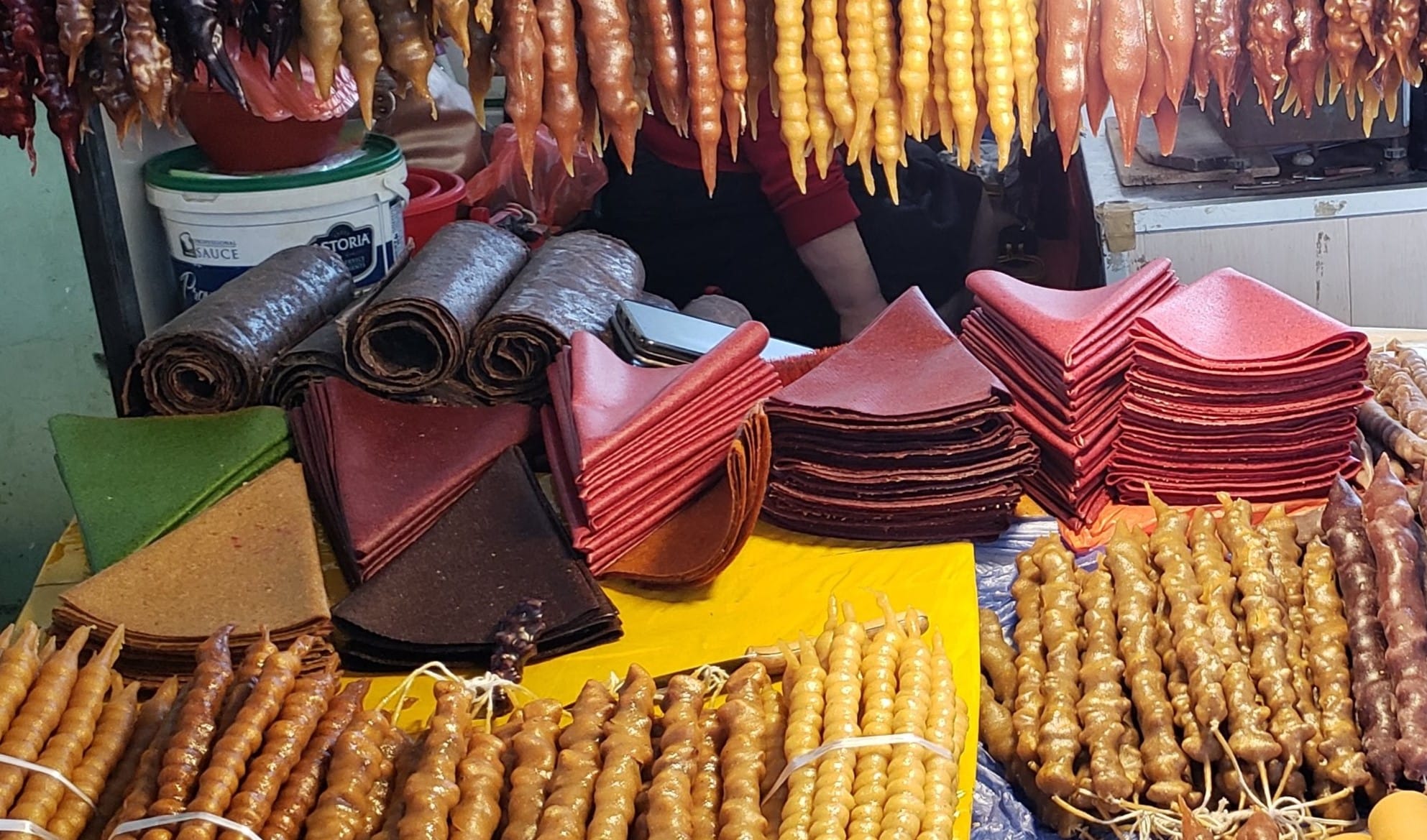
Tklapi, Pastegh, Lavashak: One Ingredient Fruit Leather from the Caucasus
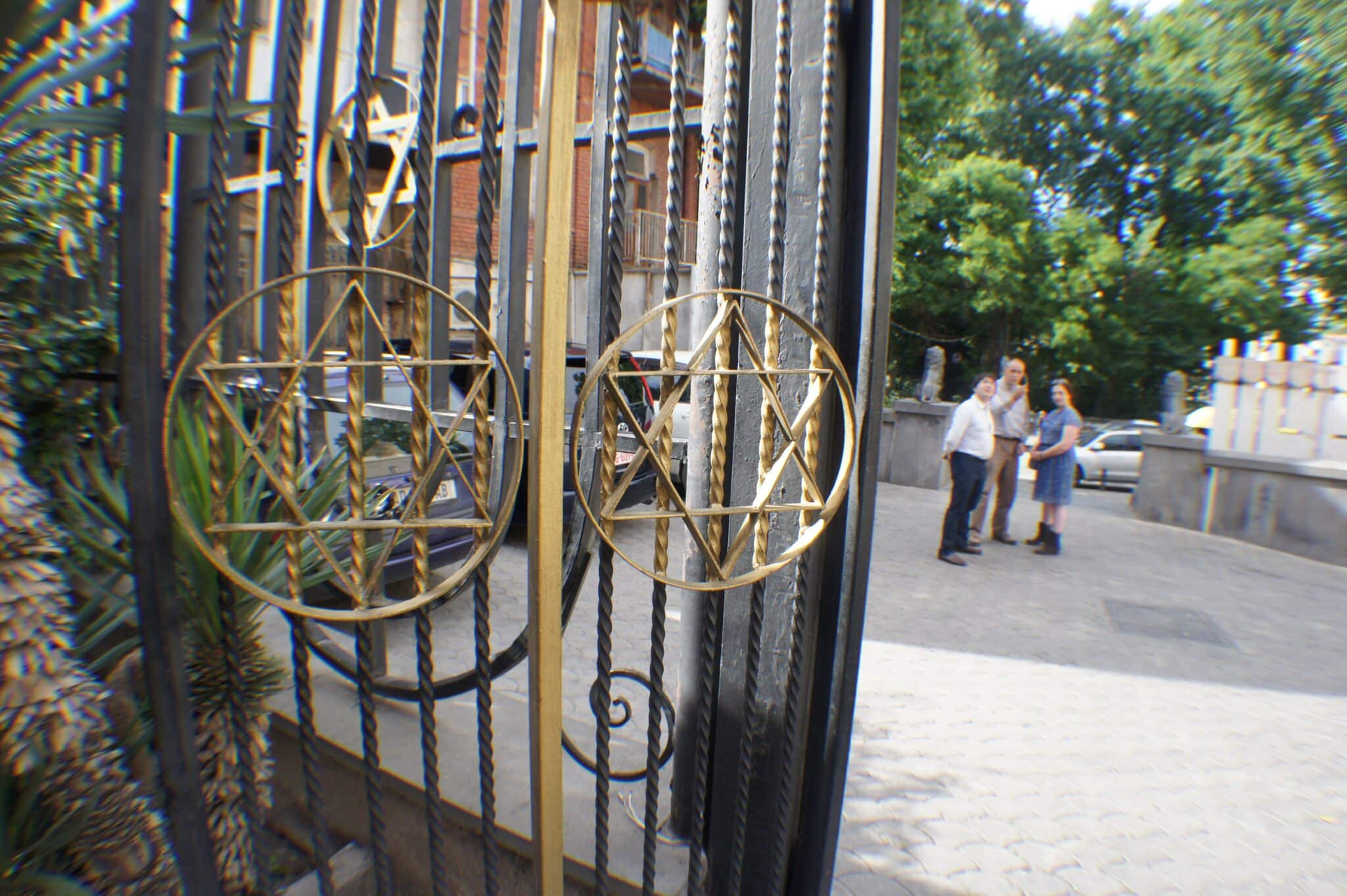
Jewish Georgia: A Brief History and Guide

The Habits of Nuns in Catholic and Orthodox Traditions


